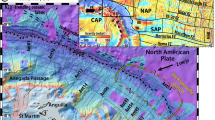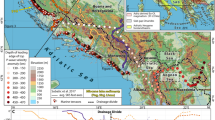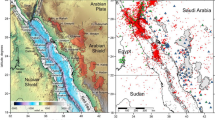Abstract
The Central Andes are the Earth's highest mountain belt formed by ocean–continent collision1,2. Most of this uplift is thought to have occurred in the past 20 Myr, owing mainly to thickening of the continental crust2,3,4,5,6, dominated by tectonic shortening7,8,9,10. Here we use P-to-S (compressional-to-shear) converted teleseismic waves observed on several temporary networks in the Central Andes to image the deep structure associated with these tectonic processes. We find that the Moho (the Mohorovičić discontinuity—generally thought to separate crust from mantle) ranges from a depth of 75 km under the Altiplano plateau to 50 km beneath the 4-km-high Puna plateau. This relatively thin crust below such a high-elevation region indicates that thinning of the lithospheric mantle may have contributed to the uplift of the Puna plateau. We have also imaged the subducted crust of the Nazca oceanic plate down to 120 km depth, where it becomes invisible to converted teleseismic waves, probably owing to completion of the gabbro–eclogite transformation; this is direct evidence for the presence of kinetically delayed metamorphic reactions in subducting plates. Most of the intermediate-depth seismicity in the subducting plate stops at 120 km depth as well, suggesting a relation with this transformation. We see an intracrustal low-velocity zone, 10–20 km thick, below the entire Altiplano and Puna plateaux, which we interpret as a zone of continuing metamorphism and partial melting that decouples upper-crustal imbrication from lower-crustal thickening.
This is a preview of subscription content, access via your institution
Access options
Subscribe to this journal
Receive 51 print issues and online access
$199.00 per year
only $3.90 per issue
Buy this article
- Purchase on Springer Link
- Instant access to full article PDF
Prices may be subject to local taxes which are calculated during checkout




Similar content being viewed by others
References
DeMets, C., Gordon, R. G., Argus, D. F. & Stein, S. Current plate motions. Geophys. J. Int. 101, 425–478 (1990).
Isacks, B. L. Uplift of the central Andean plateau and bending of the Bolivian orocline. J. Geophys. Res. 93, 3211– 3231 (1988).
James, D. E. Andean crustal and upper mantle structure. J. Geophys. Res. 76, 3246–3271 (1971).
Wigger, P. J. et al. in Tectonics of the Southern Central Andes (eds Reutter, K. -J., Scheuber, E. & Wigger, P. J.) 23–48 (Springer, Berlin, 1994).
Zandt, G., Velasco, A. A. & Beck, S. L. Composition and thickness of the southern Altiplano crust, Bolivia. Geology 22, 1003– 1006 (1994).
Beck, S. L. et al. Crustal thickness variations in the Central Andes. Geology 24, 407–410 ( 1996).
Allmendinger, R. W. & Gubbels, T. Pure and simple shear plateau uplift, Altiplano-Puna, Argentina and Bolivia. Tectonophysics 259, 1–13 ( 1996)
Kley, J. & Monaldi, C. R. Tectonic shortening and crustal thickness in the central Andes: how good is the correlation? Geology 26, 723–726 ( 1998).
Lamb, S., Hoke, L., Kennan, L. & Dewey, J. in Orogeny Through Time (eds Burg, J. P. & Ford, M.) 237–264 (Special Publication 121, Geological Society, London, 1997).
Allmendinger, R. W., Jordan, T. E., Kay, S. M. & Isacks, B. L. The evolution of the Altiplano-Puna Plateau of the Central Andes. Annu. Rev. Earth Planet. Sci. 26, 139– 174 (1997).
Owens, T. J., Zandt, G. & Taylor, S. R. Seismic evidence for an ancient rift beneath the Cumberland Plateau, Tennessee: A detailed analysis of broadband teleseismic P waveforms. J. Geophys. Res. 89, 7783– 7795 (1984).
Yuan, X., Ni, J., Kind, R., Mechie, J. & Sandvol, E. Lithospheric and upper mantle structure of southern Tibet from a seismological passive source experiment. J. Geophys. Res. 102, 27491–27500 ( 1997).
Jones, C. H. & Phinney, R. A. Seismic structure of the lithosphere from teleseismic converted arrivals observed at small arrays in the southern Sierra Nevada and vicinity, California. J. Geophys. Res. 103, 10065–10090 (1998).
Kosarev, G. et al. Seismic evidence for a detached Indian lithospheric mantle beneath Tibet. Science 283, 1306– 1309 (1999).
Kay, R. W. & Kay, S. M. Delamination and delamination magmatism. Tectonophysics 219, 177– 189 (1993).
Cassidy, J. F. Numerical experiments in broadband receiver function analysis. Bull. Seismol. Soc. Am. 82, 1453–1474 (1992).
Sobolev, S. V. & Babeyko, A. Yu. Modelling of mineralogical composition, density and elastic wave velocities in the unhydrous rocks. Surv. Geophys. 15, 515– 544 (1994).
Peacock, S. M. The importance of blueschist - eclogite dehydration reactions in subducting oceanic crust. Geol. Soc. Am. Bull. 105, 684–694 (1993).
Kirby, S., Engdahl, E. R. & Denlinger, R. in Subduction Top to Bottom (eds Bebout, G. E., Scholl, D. W., Kirby, S. H. & Platt, J. P.) 195– 214 (Geophysical Monograph 96, American Geophysical Union, Washington DC, 1996).
ANCORP Working Group. Seismic reflection image of Andean subduction zone revealing offset of intermediate-depth seismicity into oceanic mantle. Nature 397, 341– 344 (1999).
Lucassen, F., Lewerenz, S. & Franz, G. Metamorphism, isotopic ages and composition of lower crustal granulite xenoliths from the Cretaceous Salta Rift, Argentina. Contrib. Mineral. Petrol. 134, 325– 341 (1999).
Chmielowski, J., Zandt, G. & Haberland, C. The central Andean Altiplano-Puna Magma body. Geophys. Res. Lett. 26, 783–786 (1999).
Giese, P., Scheuber, E., Schilling, F., Schmitz, M. & Wigger, P. Crustal thickening processes in the Central Andes and the different natures of the Moho-discontinuity. J. S. Am. Earth Sci. 12, 201–220 (1999).
Nelson, K. D. et al. Partially molten middle crust beneath southern Tibet: Synthesis of project INDEPTH results. Science 274, 1684–1688 (1996).
Kind, R. et al. Evidence from earthquake data for a partially molten crustal layer in southern Tibet. Science 274, 1692 –1694 (1996).
Hacker, B. R. et al. Hot and dry deep crustal xenoliths from Tibet. Science 287, 2463–2466 ( 2000).
Cahill, T. A. & Isacks, B. L. Seismicity and shape of the subducted Nazca Plate. J. Geophys. Res. 97, 17503– 17529 (1992).
Graeber, F. & Asch, G. Three dimensional models of P wave velocity and P to S velocity ratio in the southern central Andes by simultaneous inversion of local earthquake data. J. Geophys. Res. 104, 20237–20256 (1999).
Engdahl, E. R., van der Hilst, R. D. & Buland, R. Global teleseismic earthquake relocation with improved travel times and procedures for depth determination. Bull. Seismol. Soc. Am. 88, 722–743 ( 1998).
Acknowledgements
We thank R. Trumbull and F. Lucassen for discussions, J. Mechie and D. Harlov for comments on the manuscript, and G. Chong and M. Wilke for supporting the experiments. The field experiments were supported by the Collaborative Research Center (SFB) 267 of the Deutsche Forschungsgemeinschaft, the GeoForschungsZentrum Potsdam, the Freie Universität Berlin, the US National Science Foundation, the PASSCAL project, the Universidad de Chile (Santiago) and the Universidad Catolica del Norte (Antofagasta).
Author information
Authors and Affiliations
Corresponding author
Supplementary information
Rights and permissions
About this article
Cite this article
Yuan, X., Sobolev, S., Kind, R. et al. Subduction and collision processes in the Central Andes constrained by converted seismic phases. Nature 408, 958–961 (2000). https://doi.org/10.1038/35050073
Received:
Accepted:
Issue Date:
DOI: https://doi.org/10.1038/35050073
This article is cited by
-
Imaging the subsurface architecture in porphyry copper deposits using local earthquake tomography
Scientific Reports (2023)
-
Joint inversion of receiver functions and surface wave dispersion velocities to investigate the crustal structure of north of Morocco: case of Rif domain
Mediterranean Geoscience Reviews (2022)
-
How fluid infiltrates dry crustal rocks during progressive eclogitization and shear zone formation: insights from H2O contents in nominally anhydrous minerals
Contributions to Mineralogy and Petrology (2022)
-
Subduction zone fluids and arc magmas conducted by lithospheric deformed regions beneath the central Andes
Scientific Reports (2021)
-
The Hindu Kush slab break-off as revealed by deep structure and crustal deformation
Nature Communications (2021)
Comments
By submitting a comment you agree to abide by our Terms and Community Guidelines. If you find something abusive or that does not comply with our terms or guidelines please flag it as inappropriate.



